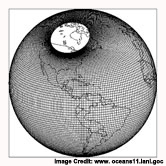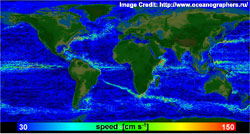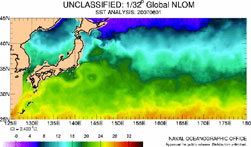General Circulation Model (GCM) Modeling Overview
Overview | Results
Numerical simulations offer a unique look at the time and space variability of the North Pacific Subtropical Mode Water (STMW).
1/10° Parallel Ocean Program General Circulation Model
 The Parallel Ocean Program (POP) is a three-dimensional, z-level, primitive equation general circulation ocean model with an implicit free surface. The model has 1/10° horizontal spacing at the equator, employs a displaced pole grid in the Northern Hemisphere to allow the inclusion of the Arctic Ocean, and uses 40 vertical levels. It includes a K-Profile Parameterization (KPP) mixed layer. Details of the model formulation can be found at http://climate.lanl.gov/Models/POP/.
The Parallel Ocean Program (POP) is a three-dimensional, z-level, primitive equation general circulation ocean model with an implicit free surface. The model has 1/10° horizontal spacing at the equator, employs a displaced pole grid in the Northern Hemisphere to allow the inclusion of the Arctic Ocean, and uses 40 vertical levels. It includes a K-Profile Parameterization (KPP) mixed layer. Details of the model formulation can be found at http://climate.lanl.gov/Models/POP/.
 One goal of the present study is to focus on an important physical process, namely the formation and erosion of STMW, to understand how the model performs: in what ways it is successful and where it fails. The model also allows us to calculate the potential vorticity (PV) budget of the density layer containing the STMW.
One goal of the present study is to focus on an important physical process, namely the formation and erosion of STMW, to understand how the model performs: in what ways it is successful and where it fails. The model also allows us to calculate the potential vorticity (PV) budget of the density layer containing the STMW.
1/32° Global NLOM Nowcast/Forecast System
 The 1/32° global NLOM nowcast/forecast system became operational on 6 Mar 2006 as an upgrade to the 1/16° global NLOM system that ran operationally at NAVOCEANO from 27 Sep 2001 – 5 Mar 2006. Overall, the 1/16° NLOM ran in real-time 18 Oct 2000 – 11 Mar 2006 and was discontinued 12 Mar 2006 and the 1/32° NLOM has been running in real time or near real time since 1 Nov 2003. The model presently is assimilating SSH from 3 satellite altimeters (ENVISAT, GFO and JASON-1) and sea surface temperature from satellite IR imagery. Altimeter track data over a 3-day window are assimilated each day. Nowcasts are run daily and 30-day forecasts are presently run once per week.
The 1/32° global NLOM nowcast/forecast system became operational on 6 Mar 2006 as an upgrade to the 1/16° global NLOM system that ran operationally at NAVOCEANO from 27 Sep 2001 – 5 Mar 2006. Overall, the 1/16° NLOM ran in real-time 18 Oct 2000 – 11 Mar 2006 and was discontinued 12 Mar 2006 and the 1/32° NLOM has been running in real time or near real time since 1 Nov 2003. The model presently is assimilating SSH from 3 satellite altimeters (ENVISAT, GFO and JASON-1) and sea surface temperature from satellite IR imagery. Altimeter track data over a 3-day window are assimilated each day. Nowcasts are run daily and 30-day forecasts are presently run once per week.
The 1/32° global NLOM nowcast/forecast system was used during the cruises to locate the Kuroshio Extension.